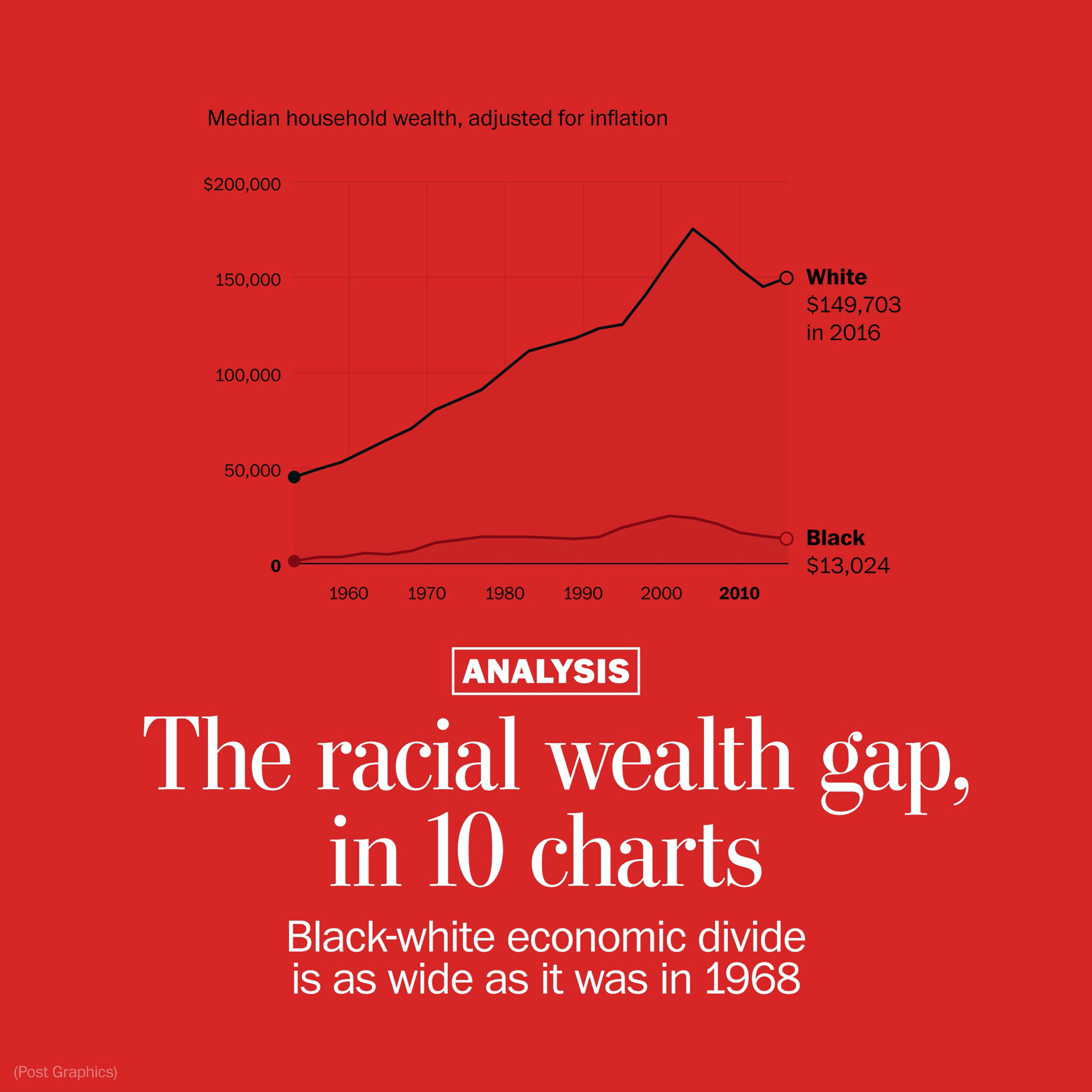As Black Lives Matter protests grow across the nation over policing, the deep economic inequalities that African Americans face are coming to the forefront.
In many ways, the gap between the finances of blacks and whites is still as wide in 2020 as it was in 1968, when a run of landmark civil rights legislation culminated in the Fair Housing Act in response to centuries of unequal treatment of African Americans in nearly every part of society and business.
In the decades since, white wealth has soared while black wealth has stagnated. Many have pointed out the far larger share of white millionaires than black, but even among the middle class, the inequities are stark.
In 1968, a typical middle-class black household had $6,674 in wealth compared with $70,786 for the typical middle-class white household, according to data from the historical Survey of Consumer Finances that has been adjusted for inflation. In 2016, the typical middle-class black household had $13,024 in wealth versus $149,703 for the median white household, an even larger gap in percentage terms.
“The historical data reveal that no progress has been made in reducing income and wealth inequalities between black and white households over the past 70 years,” wrote economists Moritz Kuhn, Moritz Schularick and Ulrike I. Steins in their analysis of U.S. incomes and wealth since World War II.
As of 2016, the most recent year for which data is available, you would have to combine the net worth of 11.5 black households to get the net worth of a typical white U.S. household.
“Everybody knows that people of color are at an incredible economic disadvantage, but few realize it’s as bad or worse than it was before Civil Rights,” said Karen Petrou, managing partner of Federal Financial Analytics. “Black Lives Matter has shown that we don’t have Selma Bridge anymore, but the situation today is profoundly troubling.”
Wealth takes into account not just the wages that people earn for work, but homes, stock-market investments and other assets they have. More wealth makes for more a comfortable, safer living. And, more importantly, it is passed on to the next generation. Their parents’ wealth gives many white children a boost at birth, an advantage many of their black peers lack.
Higher education has long been touted as a ticket to the middle class, but for black Americans that has not been as true as one might hope. The typical black household headed by someone with an advanced degree has less wealth than a white household with only a high school diploma.
The wealth gap is even more pronounced among less-educated Americans. A white household whose head has only a high school diploma has almost 10 times the wealth of a black family with the same education. The fact that black families start off with so much less wealth makes it difficult to catch up, research has found.
“There are no actions that black Americans can take unilaterally that will have much of an effect on reducing the racial wealth gap,” concluded a 2018 report on the wealth gap from the Samuel Du Bois Cook Center on Social Equity.
The coronavirus crisis hit blacks especially hard
The first economic victims of the covid-19 crisis were the service industries that employ disproportionate numbers of black and brown workers. As a result, after the Great Lockdown this spring, fewer than half of all black adults had a job.
The latest Labor Department figures, from April, show that 48.8 percent of black adults were employed, tying two months in the early 1980s for the worst rate on record. The equivalent rates for white and Hispanic Americans have also dropped precipitously, but remain above 50 percent.
There is real potential for an economic depression — a deep and long-lasting downturn — among black and Hispanic workers, even if the rest of the economy rebounds somewhat, says Darrick Hamilton, executive director of the Kirwan Institute for the Study of Race and Ethnicity at Ohio State University.
Federal Reserve Chair Jerome H. Powell, one of the nation’s top economic policymakers, has warned repeatedly in recent weeks that the pandemic is hitting low-income workers the hardest, especially minority females. It is increasing inequality, he said.
“The pandemic is falling on those least able to bear its burdens. It is a great increaser of inequality,“ Powell said in a recent videoconference with Princeton University. “It is low-paid workers in the service industries who are bearing the brunt of this.”
It is a similar story among black businesses. An analysis of Labor Department data by University of California, Santa Cruz economist Robert Fairlie found that more than 2 out of 5 black small businesses and self-employed workers have been forced to shutter during the pandemic — well over twice the rate of white businesses. Many could close permanently, Fairlie said.
It should not be surprising, then, that most black (and Hispanic) workers report that they have lost income since the crisis began. A special survey by the U.S. Census in late April and early May revealed how stark the situation is for African Americans.
The most popular and interesting stories of the day to keep you in the know. In your inbox, every day.
More than 1 in 5 black families now report they often or sometimes do not have enough food — more than three times the rate for white families. Black families are also almost four times as likely as whites to report they missed a mortgage payment during the crisis — numbers that do not bode well for the already low black homeownership rate.
With far less savings or wealth to draw on, blacks were especially vulnerable to the downturn. That does not even begin to address the higher hospitalization and death rates African Americans face from the novel coronavirus itself.
“This idea that we’re all in this together is sort of a false statement to make,” said Valerie Wilson, director of the Economic Policy Institute’s Program on Race, Ethnicity, and the Economy. “Black workers are the least likely to be able to work from home.”
Black Americans were already in a precarious position before covid-19
By many measures, black Americans have lost ground financially since the Great Recession. They regained jobs, incomes and homes much more slowly than whites.
While many Americans welcomed the news that middle-class income hit an all-time high in 2018, that was not true for black Americans. They are still earning less than they did in 2000, according to inflation-adjusted figures from the Census Bureau. Other racial groups — whites, Hispanics and Asians — have all surpassed their prior peak, but the median black income remains more than $2,000 below where it was in 2000.
As their incomes did not rebound as quickly, many black Americans were not able to rebuild their savings before the global pandemic hit. Depleted cash reserves put black Americans in an astonishingly precarious position heading into the crisis. They did not have the cash on hand to pay for basic needs, including health care.
“The black population was penniless to deal with this health crisis,” said Hamilton. “The little wealth black people had is typically tied up in their home.”
On average, black households had $8,762 in cash or equivalent liquid assets compared with $49,529 for white households, according to government data analyzed by the Economic Policy Institute. Black households with a high school degree or less had, on average, only $5,289 in liquid assets.
It’s not just wealth. Black Americans face endless inequities.
Blacks are more likely than whites to face discrimination in the workplace or in having loan applications approved, studies have repeatedly shown, making it harder to get ahead. Median weekly pay for black men is only 75 percent the $1,096 that white men earn, according to the latest Labor Department data. Even among black and white workers, with similar resumes, studies have found black workers are far less likely to get called for an interview if a hiring manager can tell the applicant is black.
The prejudices play out in a number of ways. Only 44 percent of black households own their homes compared with nearly 74 percent of whites. The black homeownership rate is little changed from the late 1960s, while whites have made steady gains over time.
In an era when the entire U.S. workforce is becoming more educated, U.S. colleges are still failing to help black students graduate. The Department of Education tracks incoming college freshman classes to determine how many students graduate within six years. Whites, Hispanics and Asians have all seen their college completion rates rise since 1996. Blacks have not.
Only a third of black men who enter college graduate in six years — that is nearly half the rate of white men, according to the latest data. A growing body of research shows that African American students are more likely than whites to have student debt and that financial burden of that often forces these students to drop out.
While deep inequalities remain, some are hopeful that the protests nationwide could be a turning point for blacks in America.
“I’m hopeful of younger generations. To the extent white people, particularly white youth, are willing to sacrifice white privilege for justice, then we can have a different society that is more moral,” said Hamilton, the head of the Kirwan Institute for the Study of Race and Ethnicity.




